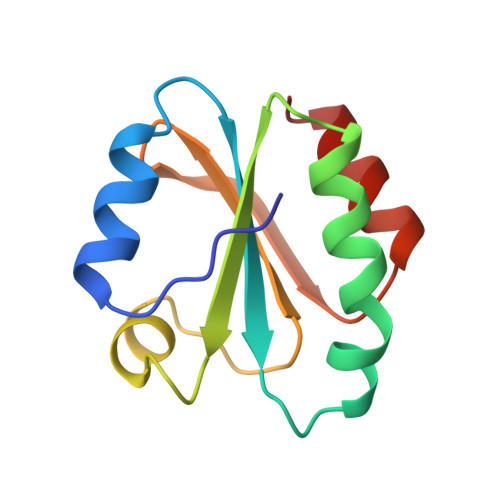Human thioredoxin homodimers: regulation by pH, role of aspartate 60, and crystal structure of the aspartate 60 --> asparagine mutant.
Andersen, J.F., Sanders, D.A., Gasdaska, J.R., Weichsel, A., Powis, G., Montfort, W.R.(1997) Biochemistry 36: 13979-13988
- PubMed: 9369469
- DOI: https://doi.org/10.1021/bi971004s
- Primary Citation of Related Structures:
1AIU, 1AUC - PubMed Abstract:
Thioredoxins are a group of ca. 12 kDa redox proteins that mediate numerous cytosolic processes in all cells. Human thioredoxin can be exported out of the cell where it has additional functions including the ability to stimulate cell growth. A recent crystal structure determination of human thioredoxin revealed an inactive dimeric form of the protein covalently linked through a disulfide bond involving Cys 73 from each monomer [Weichsel et al. (1996) Structure 4, 735-751]. In the present study, apparent dissociation constants (Kapp) for the noncovalently linked dimers were determined at various pHs using a novel assay in which preformed dimers, but not monomers, were rapidly linked through oxidation (with diamide) of the Cys 73 disulfide bond, and the relative amounts of monomer and dimer were detected by gel filtration. The values obtained were pH-dependent, varying between 6.1 and 166 microM for the pH range of 3.8-8.0, and were consistent with the titration of a single ionizable group having a pKa of 6.5. A similar value was obtained using gel filtration at pH 3.8 (Kapp = 164 microM), and the crystal structure of the diamide-oxidized protein was determined to be nearly identical to that obtained in the absence of diamide. Asp 60 lies in the dimer interface and was found to be responsible for the pH dependence for dimer formation, and therefore must have a pKa elevated by approximately 2.5 pH units. Mutation of Asp 60 to asparagine abolished nearly all of the pH dependence for dimer formation. The crystal structure of the D60N mutant revealed a dimer nearly identical to the wild type, but, surprisingly, it had the Asn 60 side chain rotated out of the dimer interface and replaced with two water molecules. The values obtained for Kapp suggest human thioredoxin may dimerize in vivo and possible roles for such dimers are discussed.
Organizational Affiliation:
Department of Biochemistry and Arizona Cancer Center, University of Arizona, Tucson, Arizona 85721, USA.














